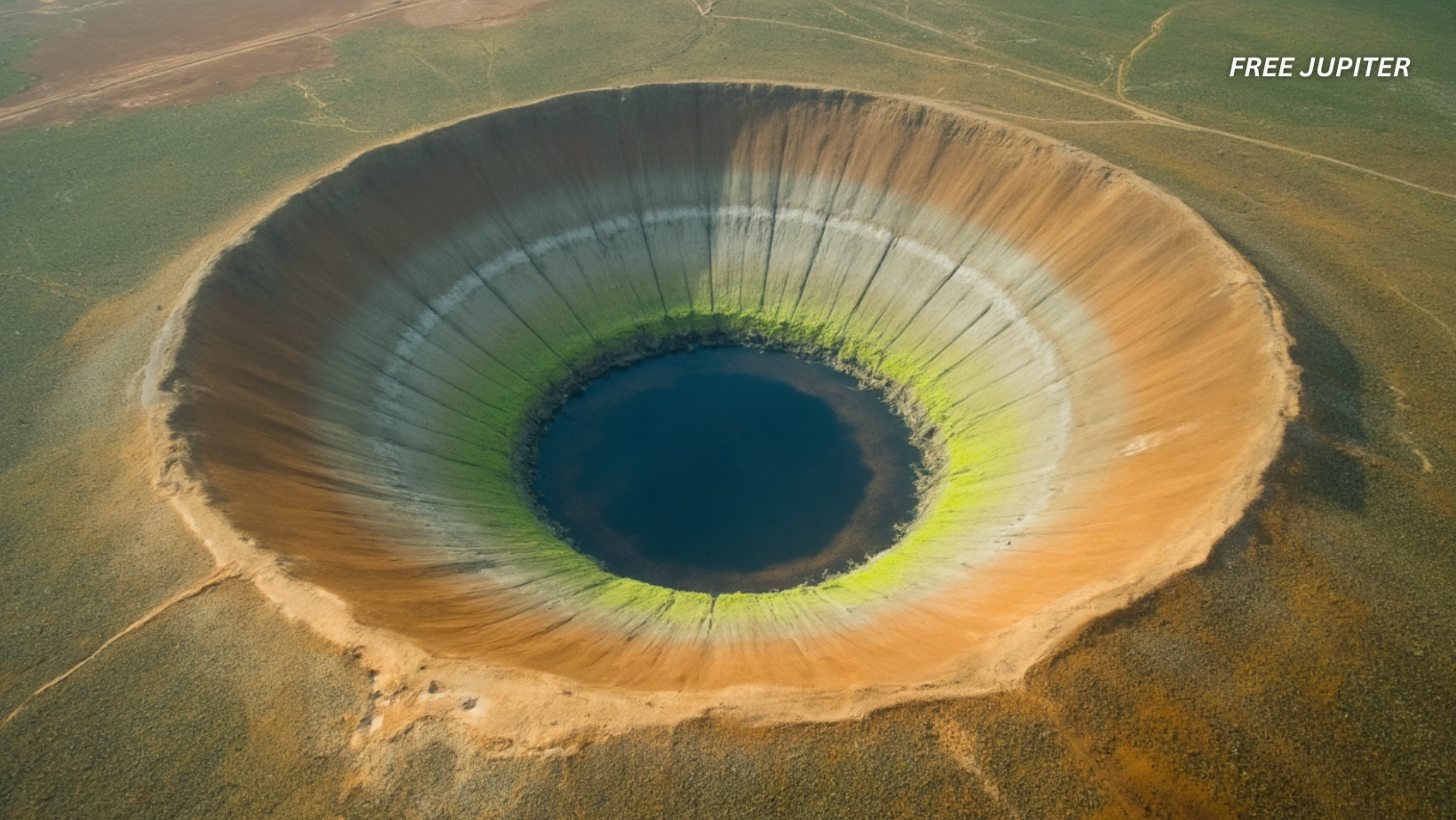A newly identified impact site in Australia’s Pilbara region has emerged as the oldest known meteorite crater on Earth, dating back approximately 3.5 billion years. This remarkable finding not only pushes back the timeline of cosmic collisions on our planet by over a billion years but also invites fresh perspectives on how life might have begun here, potentially with extraterrestrial contributions.
The Pilbara Crater: A Window into Earth’s Deep Past
Located in Western Australia’s ancient Pilbara Craton, the newly confirmed impact structure spans roughly 100 kilometers in diameter. Geological investigations have revealed that this crater formed around 3.47 billion years ago, a period coinciding closely with the earliest evidence of microbial life on Earth. Prior to this discovery, the oldest recognized impact site was the Yarrabubba crater, also in Australia, but significantly younger at about 2.2 billion years old.
The crater’s identification was made possible through the study of distinctive geological features such as shatter cones: conical fractures in bedrock that form exclusively under the intense pressures generated by high-velocity impacts. These formations, found in abundance at the Pilbara site, serve as unequivocal proof of a colossal meteorite strike, estimated to have occurred at speeds exceeding 36,000 kilometers per hour (around 22,000 miles per hour).
More Than a Scar: The Crater’s Role in Life’s Origins
While impact craters are often viewed as destructive scars, the Pilbara crater may have played a nurturing role in Earth’s biological beginnings. The collision would have unleashed energy surpassing many nuclear detonations, drastically altering the local environment. However, this upheaval likely created hydrothermal systems-hot, mineral-rich pools-that could foster the synthesis of complex organic molecules essential for life.
Scientists propose that such hydrothermal environments, rich in heat and chemical nutrients, mirror habitats where extremophiles thrive today, such as volcanic vents on the ocean floor. These conditions provide natural laboratories where simple molecules can assemble into more complex structures, potentially jumpstarting primitive life forms.
Read more: Florida Man Gored by Massive Bison at Yellowstone After Ignoring Wildlife Distance Guidelines
Cosmic Delivery of Life’s Building Blocks
Intriguingly, the Pilbara impact event may have done more than reshape Earth’s surface; it might have delivered vital genetic components from space. Research by NASA and other institutions has identified DNA nucleobases-adenine, guanine, cytosine, and thymine-within meteorites recovered from Antarctica and Australia. These molecules are fundamental to genetic coding and suggest that space environments can synthesize and transport life’s precursors.
Given that smaller meteorites carry such organic compounds, the enormous meteorite responsible for the Pilbara crater could have introduced a substantial payload of extraterrestrial organic material. This raises the possibility that life’s earliest genetic blueprints on Earth were seeded by cosmic sources, blending terrestrial and extraterrestrial chemistry in the planet’s formative years.
Impact Chemistry: Nature’s Molecular Forge
The extreme heat and pressure generated by the Pilbara impact would have triggered chemical reactions capable of producing amino acids, sugars, and other organic compounds-the essential ingredients for life. Laboratory simulations replicating such conditions have successfully synthesized these molecules, supporting the idea that meteorite impacts do not merely deliver life’s building blocks but actively manufacture them through shock-induced chemistry.
This natural “forge” effect implies that cosmic collisions could have served as catalysts, accelerating the emergence of life by creating complex organic molecules from simpler precursors in the chaotic aftermath of impact.
Read more: Experts Reveal the 3 Most Spiritually Heightened Birth Months—Is Yours on the List?
Timing and Evolutionary Implications
The temporal proximity between the Pilbara impact and the earliest microbial fossils-dated at about 3.5 billion years ago-is striking. Such alignment suggests the impact event may have set the stage for life’s rapid appearance, providing both the raw materials and the environmental conditions conducive to biological innovation.
Moreover, the environmental disruption caused by the impact likely imposed selective pressures on nascent life forms, encouraging rapid adaptation. Microbes surviving these harsh conditions would have evolved advanced mechanisms for DNA repair and replication, potentially paving the way for more complex genetic systems and the diversification of life.
A Universal Signature? DNA’s Cosmic Connections
If the fundamental components of DNA arrived from space, it opens the door to the idea that life is not unique to Earth but part of a broader cosmic phenomenon. Organic molecules have been detected in asteroids, Martian soil, and interstellar clouds, suggesting that the chemical foundations for life are widespread throughout the galaxy.
The Pilbara crater discovery supports the panspermia hypothesis-the concept that life or its precursors travel between planets via meteorites. This cosmic cross-pollination implies that Earth’s genetic heritage may be intertwined with extraterrestrial sources, hinting at a universal blueprint for life across the cosmos.
Rethinking Our Origins: Earthlings or Cosmic Descendants?
The presence of organic molecules predating Earth’s formation in meteorites suggests that life’s ingredients existed in the interstellar medium before our planet came into being. If the Pilbara impact introduced extraterrestrial DNA components, it implies that life on Earth began not solely from terrestrial chemistry but from materials and processes that originated in space.
This perspective challenges traditional views of human and planetary origins, positioning us as participants in a vast cosmic lineage rather than isolated Earth-bound entities. Our biological ancestry may trace back to molecular seeds that journeyed across the galaxy long before the solar system formed.
Alternative Genetic Systems and Impact Influence
NASA’s experiments with synthetic “hachimoji” DNA-an eight-base genetic system-demonstrate that life’s genetic code could have evolved differently under alternative chemical conditions. The specific four-base DNA system found on Earth might have been shaped by the particular organic molecules delivered by ancient meteorite impacts such as the one at Pilbara.
This suggests that the Pilbara meteorite not only contributed raw genetic materials but may have influenced the very architecture of the genetic code that governs all known life, providing a template for biological complexity.
Cosmic Exchange: Life’s Galactic Journey
If the components of life travel via meteorites, then Earth is part of a vast network of biological exchange spanning the galaxy. The Pilbara impact event exemplifies how life’s building blocks might spread through space, supporting the notion that life’s emergence on Earth was a chapter in a much larger cosmic story.
This galactic perspective transforms our understanding of biology, linking terrestrial evolution with interstellar processes and suggesting that life’s origins are as much a matter of cosmic history as planetary geology.
Read more: Scientists May Have Located the “Missing Half” Of Universe’s Matter
Conclusion: A Paradigm Shift in Understanding Life’s Beginnings
The discovery of the Pilbara crater reshapes scientific narratives about Earth’s early history and the origins of life. It provides concrete evidence that meteorite impacts played a critical role in delivering and synthesizing organic compounds essential for life’s emergence.
Far from being mere destructive events, such impacts may have created the environmental conditions and molecular ingredients necessary for life to flourish. This realization expands the search for life beyond Earth, from a question of possibility to one of probability, as we consider ourselves part of a vast cosmic heritage written in the ancient scars of our planet.
In essence, the Pilbara crater stands as a testament to the intertwined fates of Earth and the cosmos, reminding us that our story may have begun not just on this planet but among the stars.










